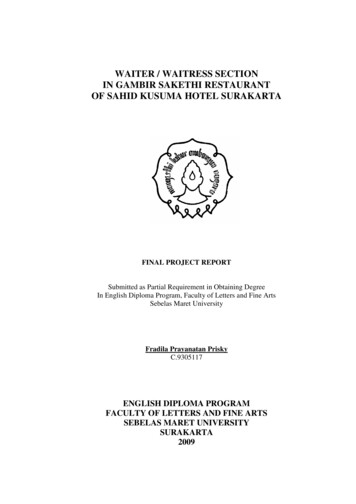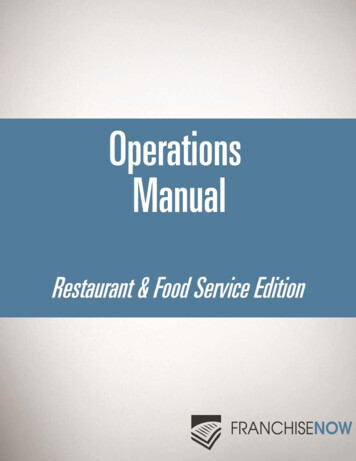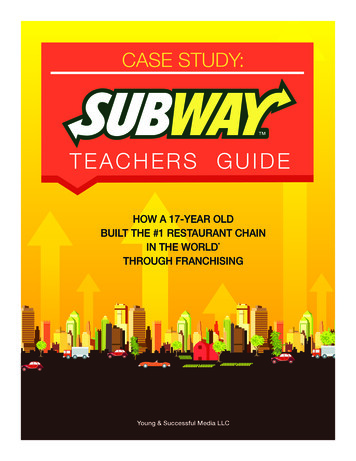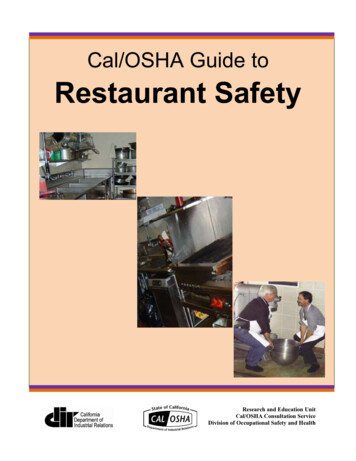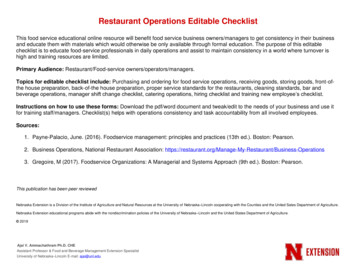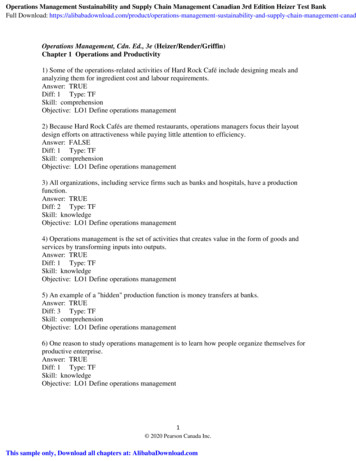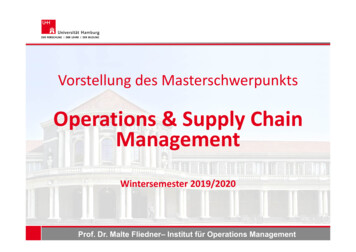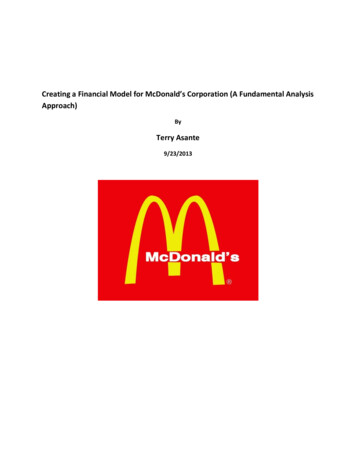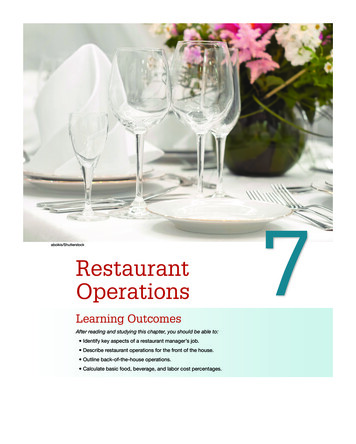
Transcription
aboikis/ShutterstockRestaurantOperationsLearning Outcomes7After reading and studying this chapter, you should be able to: Identify key aspects of a restaurant manager’s job. Describe restaurant operations for the front of the house. Outline back-of-the-house operations. Calculate basic food, beverage, and labor cost percentages.M07 WALK4919 04 SE C07.indd 12906/11/17 3:12 PM
The job of restaurant general manager or managing partner, if theyown a stake in the business, is very challenging and demanding,and requires strong leadership and organizational skills. First, letus analyze the job by examining the key areas of the job.5. Evaluate progress of employees during training.Restaurant ManagerJob Analysis8. Complete reports or other written documentation on successful completion of training by employees.6. Supervise on-site training of employees that is conductedby another manager, employee leader, trainer, and so on.7. Conduct payroll signup.Scheduling for Shifts1. Review employee work schedule for shift.Learning Outcome 1: Identify key aspects of a restaurant2. Determine staffing needs for each shift.manager’s job.3. Make work assignments for dining room, kitchen staff,and maintenance person(s).The National Restaurant Association (NRA), the largest industryassociation, which represents over 500,000 restaurant businesses, has formulated an analysis of the foodservice manager’sjob by functional areas and tasks. This analysis follows a naturalsequence of functional areas from human resources to sanitationand safety.Human Resource Management4. Make changes to employee work schedule.5. Assign employees to work stations to optimize employeeeffectiveness.6. Call in, reassign, or send home employees in reaction tosales and other needs.7. Approve requests for schedule changes, vacation, daysoff, and so on.Recruiting/TrainingSupervision and Employee Development1. Recruit new employees by seeking referrals.2. Recruit new employees by advertising.3. Recruit new employees by seeking help from districtmanager/supervisor.1. Observe employees and give immediate feedback on unsatisfactory employee performance.4. Interview applicants for employment.2. Observe employees and give immediate feedback on satisfactory employee performance.Orientation/Training3. Discuss unsatisfactory performance with an employee.4. Develop and deliver incentive for above-satisfactory performance of employees.1. Conduct on-site orientation for new employees.3. Plan training programs for employees.5. Observe employee behavior for compliance with safetyand security.4. Conduct on-site training for employees.6. Counsel employees on work-related problems.2. Explain employee benefits and compensation programs.7. Counsel employees on nonwork-related problems.8. Talk with employees who have frequent absences.10. Discipline employees by issuing oral and/or written warnings for poor performance.11. Conduct employee and staff meetings.Paul Maguire/ShutterstockCHAPTER 7 Restaurant Operations9. Observe employees to ensure compliance with fair laborstandards and equal opportunity guidelines.The job of restaurant general manager requires strong leadership and organizational skills.12. Identify and develop candidates for management programs.13. Put results of observation of employee performance inwriting.14. Develop action plans for employees to help them in theirperformance.15. Authorize promotion and/or wage increases for staff.16. Terminate employment of an employee for unsatisfactoryperformance.130M07 WALK4919 04 SE C07.indd 13006/11/17 3:12 PM
Financial ManagementAccounting1. Authorize payment on vendor invoices.Marketing Management1. Create and execute local establishment marketingactivities.2. Verify payroll.2. Develop opportunities for the establishment to providecommunity services.3. Count cash drawers.3. Carry out special product promotions.4. Prepare bank deposits.5. Assist in establishment of audits by management oroutside auditors.6. Balance cash at end of shift.7. Analyze profit and loss reports for establishment.Cost Control1. Discuss factors that impact profitability with districtmanager/supervisor.2. Check establishment figures for sales, labor costs, waste,inventory, and so on.Administrative ManagementScheduling/Coordinating1. Establish objectives for shift based on needs ofestablishment.2. Coordinate work performed by different shifts, for example, cleanup, routine maintenance, and so on.3. Complete special projects assigned by district manager/supervisor.4. Complete shift readiness checklist.Planning1. Develop and implement action plans to meet financialgoals.2. Attend off-site workshops and training sessions.Communication1. Communicate with management team by reading andmaking entries in daily communication log.2. Prepare written reports on cleanliness, food quality, personnel, inventory, sales, food waste, labor costs, and so on.4. Review memos, reports, and letters from company headquarters/main office.5. Inform district manager/supervisor of problems or developments that affect operation and performance of theestablishment.6. Initiate and answer correspondence with company, vendors, and so on.7. File correspondence, reports, personnel records, and so on.M07 WALK4919 04 SE C07.indd 131Facility Maintenance1. Conduct routine maintenance checks on facility andequipment.2. Direct routine maintenance checks on facility andequipment.3. Repair or supervise the repair of equipment.4. Review establishment evaluations with district manager/supervisor.5. Authorize the repair of equipment by outside contractor.6. Recommend upgrades in facility and equipment.Food and Beverage Operations Management1. Direct activities for opening establishment.2. Direct activities for closing establishment.3. Talk with other managers at beginning and end of shift torelay information about ongoing problems and activities.4. Count, verify, and report inventory.5. Receive, inspect, and verify vendor deliveries.6. Check stock levels and submit orders as necessary.7. Talk with vendors concerning quality of product delivered.8. Interview vendors who wish to sell products toestablishment.9. Check finished product quality and act to correctproblems.10. Work as expediter to get meals served effectively.11. Inspect dining area, kitchen, rest rooms, food lockers,storage, and parking lot.“Ray Kroc, of McDonald’s, once spent acouple of hours in a good suit with one of hisrestaurant managers cleaning up the parking lot of one of his restaurants. Word soongot around to the other stores that management begins in the parking lot and ends in thebathrooms.”Restaurant Manager Job Analysis3. Review reports prepared by other establishmentmanagers.Operations Management13106/11/17 3:12 PM
12. Check daily reports for indications of internal theft.13. Instruct employees regarding the control of waste, portionsizes, and so on.14. Prepare forecast for daily or shift food preparation.Service1. Receive and record table reservations.2. Greet familiar customers by name.3. Seat customers.the same basic duties plus any special opening or closingrequirements.An assistant restaurant manager does some of the duties ofa restaurant manager, and generally there is both an openingmanager and a closing manager.Restaurants are traditionally organized by front and backof the house. The front of the house comprises the servers,bussers, wine stewards, bartenders, and cocktail servers,while the back of the house includes the chef and kitchencooks, dishwashers, stewards, dishwashers, receivers, andstorekeepers.4. Talk with customers while they are dining.Check Your Knowledge5. Monitor service times and procedures in the dining area.6. Observe customers being served in order to correctproblems.1. Name ways that new employees are recruited.2. Explain key tasks of administrative management.7. Ask customers about quality of service.3. Explain key tasks of operations management.8. Ask customers about quality of the food product.9. Listen to and resolve customer complaints.Front of the House10. Authorize complementary meals or beverages.11. Write letters in response to customer complaints.12. Telephone customers in response to customer complaints.13. Secure and return items left by customers.Learning Outcome 2: Describe restaurant operations for thefront of the house.Sanitation and Safety1. Accompany local officials on health inspections onpremises.2. Administer first aid to employees and customers.3. Submit accident, incident, and OSHA reports.4. Report incidents to police.5. Observe employee behavior and establishmentconditions for compliance with safety and securityprocedures.CHAPTER 7 Restaurant OperationsThis comprehensive analysis of a restaurant manager’s jobdetails all the major areas that a restaurant manager will dealwith. Depending on the type of restaurant, more emphasismay be placed on one area over another – and that maychange from day to day. Next, we review the job of an assistant restaurant manager. Most restaurants go with an opening and closing manager. In either case, they perform muchRestaurant operations are generally divided between what iscommonly called front of the house and back of the house.The front of the house includes anyone with guest contact,from the hostess to the bus person. The sample organizationchart in Figure 7–1 shows the differences between the front andback of the house areas.The general manager or restaurant manager runs the restaurant. Depending on the size and sales volume of the restaurant,there may be more managers with special responsibilities, such askitchen manager, bar manager, and dining room manager. Thesemanagers are usually cross-trained in order to relieve each other.In the front of the house, restaurant operation begins withcreating and maintaining what is called curbside appeal, orkeeping the restaurant looking attractive and welcoming. RayKroc, of McDonald’s, once spent a couple of hours in a goodsuit with one of his restaurant managers cleaning up the parkinglot of one of his restaurants. Word soon got around to the otherstores that management begins in the parking lot and ends inGeneral ManagerOpening and Closing ManagersFront of the HouseBack of the HouseKitchen ManagerCooksPrep cooksExpediterReceivingDishwashingBar ManagerBar-backsBartendersCocktail serversDining Room ManagerHostessBuspersonsServersFIGURE 7–1 Restaurant Organization Chart.132M07 WALK4919 04 SE C07.indd 13206/11/17 3:12 PM
Sirtravelalot/ShutterstockThe front of the house includes anyone with guest contact, fromthe hostess to the bus person.“Working together is the key to success inthe restaurant business.”Bruce Folkins, Marina Jacks,Sarasota, FL“Management involvement is vital to thesuccess of a restaurant.”Bussers and servers may clear the entree plates, while servers suggestively sell desserts by describing, recommending, orshowing the desserts. Coffee and after-dinner cocktails are alsooffered. Suggestions for steps to take in table service includethe following: Greet the guests. Introduce and suggestively sell beverages. Suggest appetizers. Take orders. Check to see that everything is to the guests’ likingwithin two bites of the entrees. Ask if the guests would like another drink. Bring out dessert tray and suggest after-dinner drinksand coffee.In addition to the seven steps of the table service, servers areexpected to be NCO—(neat, clean, and organized)—and to helpensure that hot food is served hot, and cold food is served cold.For example, during the lunch hour, servers may be scheduled to start at 11:00 a.m. The opening group of two or threepeople is joined by the closing group of the same number ataround 11:45 p.m. If the restaurant is quiet, servers may bephased out early. When the closing group comes in, there isa quick shift meeting, line up, or “alley rally.” This provides anopportunity to review recent sales figures, discuss any promotions, and acknowledge any items that are “86'ed”—the restaurant term for a menu item that is not available. Recognitionis also given to the servers during the meetings, serving asmorale boosters.Restaurant ForecastingMost businesses, including restaurants, operate by formulatinga budget that projects sales and costs for a year on a weeklyand monthly basis. Financial viability is predicted on sales, andsales budgets are forecasts of expected business.Forecasting restaurant sales has two components: guestcounts or covers and the average guest check. Guestcounts or covers are the number of guests patronizing the restaurant over a given time period—a week, month, or year. Toforecast the number of guests for a year, the year is divided intoFront of the Housethe bathrooms. Most restaurant chains have checklists thateach manager uses. In the front of the house, the parking lot,including the flower gardens, needs to be maintained in goodorder. As guests approach the restaurant, greeters may holdthe door open and welcome them to the restaurant. At the 15thStreet Fisheries Restaurant in Ft. Lauderdale, greeters welcomethe guests by assuring them that “we’re glad you’re here!”Once inside, the greeter, or as some restaurants call them, a“smiling people greeter” (SPG), greets guests appropriatelyand, if seating is available, escorts them to a table. If there is await, the hostess will take the guests’ names and ask for theirtable preference.Aside from greeting the guests, one critical function of the hostess is to rotate arriving guests among the sections or stations.This ensures an even and timely distribution of guests—otherwiseone section may get overloaded. Guests are sometimes asked towait a few minutes even if tables are available. This is done to helpmanage the kitchen’s workload—because most kitchens havelimited space and cannot cope with too much volume at one time.The greeters maintain a book, or chart, showing the sectionsand tables so they know which tables are occupied. Greetersescort guests to the tables, present menus, and may explainspecial sales promotions. Some may also remove excess placesettings from the table.In some restaurants, servers are allocated a certain numberof tables, which may vary depending on the size of the tablesand the volume of the restaurant. Normally, five is the maximum. In other restaurants, servers rotate within their section tocover three or four tables.Servers introduce themselves and offer a variety of beverages and/or specials, or invite guests to select from the menu.This is known as suggestive selling. The server then takesthe entree orders. Often, when taking orders, the server beginsat a designated point and takes the orders clockwise from thatpoint. In this way, the server will automatically know which person is having a particular dish. When the entrees are ready,the server brings them to the table. He or she checks a fewminutes later to see if everything is to the guests’ liking andperhaps asks if they would like another beverage. Good servers are also encouraged, when possible, to pre-bus tables.133M07 WALK4919 04 SE C07.indd 13306/11/17 3:12 PM
twelve 28- and one 29-day accounting periods. The accountingperiods then are broken down into four 7-day weeks. Restaurantforecasting is done by taking into consideration meal period, dayof week, special holidays, and previous forecast materializations.In terms of number of guests, Mondays usually are quiet;business gradually builds to Friday, which is often the busiestday. Friday, Saturday, and Sunday frequently provide up to50 percent of revenue. This, however, can vary according totype of restaurant and its location.The average guest check is calculated by dividing total salesby the number of guests. Most restaurants keep such figuresfor each meal. The number of guests forecast for each day ismultiplied by the amount of the average food and beveragecheck for each meal to calculate the total forecast sales. Eachday, actual totals are compared with the forecasts. Four weeklyforecasts are combined to form one accounting period; the13 accounting periods, when totaled, become the annual total.Restaurant forecasting is used not only to calculate salesprojections but also to predict staffing levels and labor cost percentages. Much depends on the accuracy of forecasting. Oncesales figures are determined, all expenditures, fixed and variable, must be deducted to calculate profit or loss.1Point of Sale and Software SystemsThere are several Point of Sale Systems (POS) available for restaurants. Some are for large restaurants and chains like franchises, while others are better suited for smaller independentrestaurants and cafés. For example, Shopkeep is a cloud-basedServiceA discussion about restaurant service in America necessarilyincludes the topic of a 15 per hour minimum wage. This topicnaturally has people on both sides of the issue. Restaurateurslike Danny Meyer have begun paying employees 15 per hourand increased menu prices to compensate. Moo Cluck MooShots Studio/ShutterstockPhil Date/ShutterstockCHAPTER 7 Restaurant OperationsForecasting restaurant sales has two components: guest countsor covers and the average guest check.POS system for iPads that can tailor menus, monitor inventory, manage employees, market to guests, and analyze data,whereas Square is good for quick-service restaurants or cafés.It can come with a square stand that transforms an iPad into asimple cash register. NCR, a long-standing provider of POS, hasa cloud-based POS system, as do several other companies.Open Table (OT) manages walk-ins, waitlists, and reservations. This allows operators to communicate with guests beforeand after their visit (you may receive a questionnaire) or birthday wishes. Open Table is mostly used by upscale full-servicerestaurants and it costs them 2.50 per cover (or guest). Oneadvantage of Open Table is that guests can make reservations,even when the restaurant is closed, at just 0.25 per cover. OTstores useful guest information, such as seating preferences,VIP’s, dietary restrictions, and special events. OT also enablessmarter table management with floor plans to pre-assign tables,monitor table status, and assign server sections.Next Table is a cloud-based reservation and table management system for an iPad. It can manage not only table reservations, but also restaurant operations. Oracle is also acloud-based reservation system that enables guests to seetime and availability and request reservations from a restaurant’s Web site. Guests can see current availability and nexttable reservation times. No Wait is an on-demand mobile appthat helps bring guests into a restaurant and aids in their seating. Then there is the free Table Agent restaurant reservationsystem app in Cloud that offers restaurants alternatives to paidsystems. Other systems include Dine Time, Cake, and Quora,which even texts guests when their table is ready, so they canrelax at the bar or wherever. Going one step further, some fastcasual restaurants, among them Starbucks, Panera Bread,Subway, and Domino’s Pizza, have turned to order-ahead appsto extract higher sales and give guests a convenience.Great service adds tremendous value to the dining experience.134M07 WALK4919 04 SE C07.indd 13406/11/17 3:13 PM
Paul Cowan/Shutterstockseat. A gueridon is a trolley-like table with a gas burner fortableside cooking. This is the most impressive and expensive form of service. Due to the higher cost of training andemploying servers who can do French service, and giventhat sometimes the food is cold by the time the guest getsto eat, this form of service is rarely used today except invery formal service situations.American service is a method in which the food is prepared anddecoratively placed onto plates in the kitchen, carried into thedining room, and served to guests.is a quick service burger joint that is paying 15 per hour andmaking a profit. They do it with employees who multitask – oneperson is not just flipping burgers; they also bake buns, makesauces, and prepare made-to-order grass-fed burgers and freerange chicken sandwiches.2 One advantage is that employeesare more engaged in their work and that people don’t leave,which means that training is not a constant issue. Several restaurants, McDonald’s among them, have introduced touchscreen self-service kiosks. Many other chains, both quick andfull service, have engaged tablets as a solution for rising laborcosts that won’t adversely impact the guest service experience.More than ever, what American diners really want to orderwhen eating out is good service. All too often, this is not on themenu. With increased competition, however, bad service willnot be tolerated in American restaurants. Great service addstremendous value to the dining experience; something mostguests are willing to pay for.American service is a method in which the food is prepared and decoratively placed onto plates in the kitchen,carried into the dining room, and served to guests. Americanservice is a less formal—yet professional—approach preferredby today’s restaurant guests. The restaurants’ commitmentto service is evidenced by the fact that most have increasedtraining for new employees. Servers are not merely order takers; they are the salespeople of the restaurant. A server whois undereducated about the menu can seriously hurt business.Restaurants in the United States and Canada, and in manyother parts of the world, all use American service.Other types of service used less often in the United Statesinclude the following:At Posterio, in Las Vegas, servers are invited to attend aone-and-a-half-hour wine class in the restaurant; about threequarters of the 40-member staff routinely benefit from thisadditional training. The best employees are also rewardedwith monthly, semi-annual, and/or annual prizes, which couldbe 100 cash, a limousine ride, dinner at Posterio, a night’slodging at the Prescott Hotel, or a week in Hawaii. Servers atsome San Francisco restaurants role-play the various elementsof service such as greeting and seating guests, suggestive selling, correct methods of service, and guest relations to ensure apositive dining experience. A good food server in a top restaurant in many cities can earn about 50,000 a year.Good servers quickly learn to gauge guests’ satisfaction levels and needs; they check to ensure guests have everythingthey need as their entree is placed before them. Even better,they anticipate guests’ needs. For example, if the guest hasused the entree knife to eat the appetizer, then a clean oneshould automatically be placed to the guest’s right side. Inother words, the guest should not receive the entree and thenrealize that he or she needs another knife.Another example of good service is when the server doesnot have to ask everyone at the table who is eating what. Theserver should either remember or make a seating plan so thatthe correct dishes are automatically placed in front of guests.Danny Meyer, owner of New York City’s celebrated UnionSquare Café and recipient of 25 James Beard awards and4 Michelin Stars, plus 16 years on the Zagat most popular restaurants list and Outstanding Service Awards from the James BeardFoundation, gives each of the restaurant’s 95 employees—frombus person to chef—a 600 annual allowance ( 50 each a month)to eat in the restaurant and critique the experience.3 This is a verysmart move because any comments or observations come frompeers and not from Danny. His “enlightened hospitality” is basedupon the belief that putting your own employees first is key to running a meaningful and sustainable business. Danny’s 14 restaurants range from the celebrated Union Square Café, to GramercyTavern, The Modern, Blue Smoke, North End Grill, Marta, andFront of the HouseFrench Service: This service is used in very formal restaurants where the food is attractively arranged on plattersin the kitchen and brought to the table by servers andpresented to guests, after which the preparation of thefood is completed on a gueridon table beside the guest’sRussian Service: The food is cooked in the kitchen, cut,placed onto a serving dish, and beautifully garnished. Thedish is then presented to the guests and served individually by lifting the food onto the guest’s plate with a servingspoon and fork. Russian service can be used at a formalrestaurant where the servers use white gloves. Russian andFrench service share the same challenges: to get the foodto the guests quickly so it is still hot, and to keep it pricedreasonably. Russian service also is used only at very formalrestaurants; it also costs much more than American service.135M07 WALK4919 04 SE C07.indd 13506/11/17 3:13 PM
Suggestive selling can be a potent weapon in the effort to increasefood and beverage sales. Many restaurateurs cannot think of abetter, more effective, and easier way to boost profit margins. Mostguests are not offended or uncomfortable with suggestive sellingtechniques, provided servers are properly trained not to overdoit! In fact, guests may feel special that the server is in tune withtheir needs and desires. It may be that the server suggests something to the guest that he or she has never considered before.The object here is to turn servers into sellers. Guests will almostcertainly be receptive to suggestions from competent servers.On a hot day, for example, servers can suggest frozen margaritas or daiquiris before going on to describe the drink specials. Likewise, servers who suggest a bottle of fumé blanc tocomplement a fish dish, or a pinot noir or cabernet sauvignonto go with red meat, are likely to increase their restaurant’s beverage sales. Upselling takes place when a guest orders a vodkaand tonic, asking for a lower-priced “well” vodka, and the servertries to “sell” the guest on a higher-priced vodka like Stoli, KetelOne, or Grey Goose in their vodka and tonic.Check Your Knowledge1. Define curbside appeal.2. Explain the suggestion for steps to take in tableservice.3. Explain the purpose of forecasting.The back of the house is generally run by the kitchen manager and the term refers to all the areas with which guests donot normally come in contact. This includes purchasing, receiving, storing/issuing, food production, stewarding, budgeting,accounting, and control.One of the most important aspects to running a successful restaurant is having a strong back-of-the-house operation,particularly in the kitchen. The kitchen is the backbone of everyfull-service restaurant, so it must be well managed and organized. Some of the main considerations in efficiently operatingthe back of the house include staffing, scheduling, training,food cost analysis (internal controls), production, managementinvolvement, management follow-up, and employee recognition.Food ProductionPlanning, organizing, and producing food of a consistently highquality is no easy task. The kitchen manager, cook, or chefbegins the production process by determining the expectedvolume of business for the next few days. Sales during thesame period in the previous year give a good indication of theexpected volume and the breakdown of the number of sales ofeach menu item. As described earlier, ordering and receivingwill have already been done for the day’s production schedule.The kitchen manager checks the head line-cook’s order,which will bring the prep (preparation) area up to the par stockof prepared items. Most of the prep work is done in the earlypart of the morning and afternoon. Taking advantage of slowertimes allows the line cooks to do the final preparation just priorto and during the actual meal service. The kitchen layout is setup according to the business projected as well as the menudesign. Most full-service restaurants have similar layouts anddesigns for their kitchens. The layout consists of the receivingarea, walk-ins, the freezer, dry storage, prep line, salad bar,cooking line, expediter, dessert station, and service bar area.The cooking line is the most important part of the kitchenlayout. It might consist of a broiler station, pickup area, frystation, salad station, sauté station, and pizza station—just amarlee/ShutterstockCHAPTER 7 Restaurant OperationsFor a restaurant to be successful, there must be clear linesof communication between the front and back of the house.Learning Outcome 3: Outline back-of-the-house operations.Alex Staroseltsev/ShutterstockSuggestive SellingBack of the HouseHannamariah/ShutterstockShake Shack. Danny also makes time to give back to the community by being a national figure in the fight against hunger.At the critically acclaimed Inn at Little Washington in Washington,Virginia, servers are required to gauge the mood of every tableand jot a number (1 to 10) and sometimes a description (“elated,grumpy, or edgy”) on each ticket. Anything below a seven requiresa diagnosis. Servers and kitchen staff work together to try to elevatethe number to at least a nine by the time dessert is ordered. Giventhe likelihood of increased labor and health costs, more restaurantswill probably opt for a service style similar to Chipotle or Pie Wei.Planning, organizing, and producing food are critical tasks for the kitchen manager.136M07 WALK4919 04 SE C07.indd 13606/11/17 3:13 PM
few of the intricate parts that go into the setup of the back ofthe house. The size of the kitchen and its equipment are alldesigned according to the sales forecast for the restaurant andby the menu. The menu dictates the equipment needed as wellas the experience level of the cooks.The kitchen will also be set up according to what the customers prefer and order most frequently. For example, if guestseat more broiled or sautéed items, the size of the broiler andsauté must be larger to cope with the demand.Teamwork, a prerequisite for success in all areas of thehospitality and tourism industry, is especially important in thekitchen. Due to the hectic pace, pressure builds, and unlesseach member of the team excels, the result will be food that isdelayed, not up to standard, or both.While
details all the major areas that a restaurant manager will deal with. Depending on the type of restaurant, more emphasis may be placed on one area over another – and that may change from day to day. Next, we review the job of an assis-tant restaurant manager. Most restaurants go with an open-ing and c
